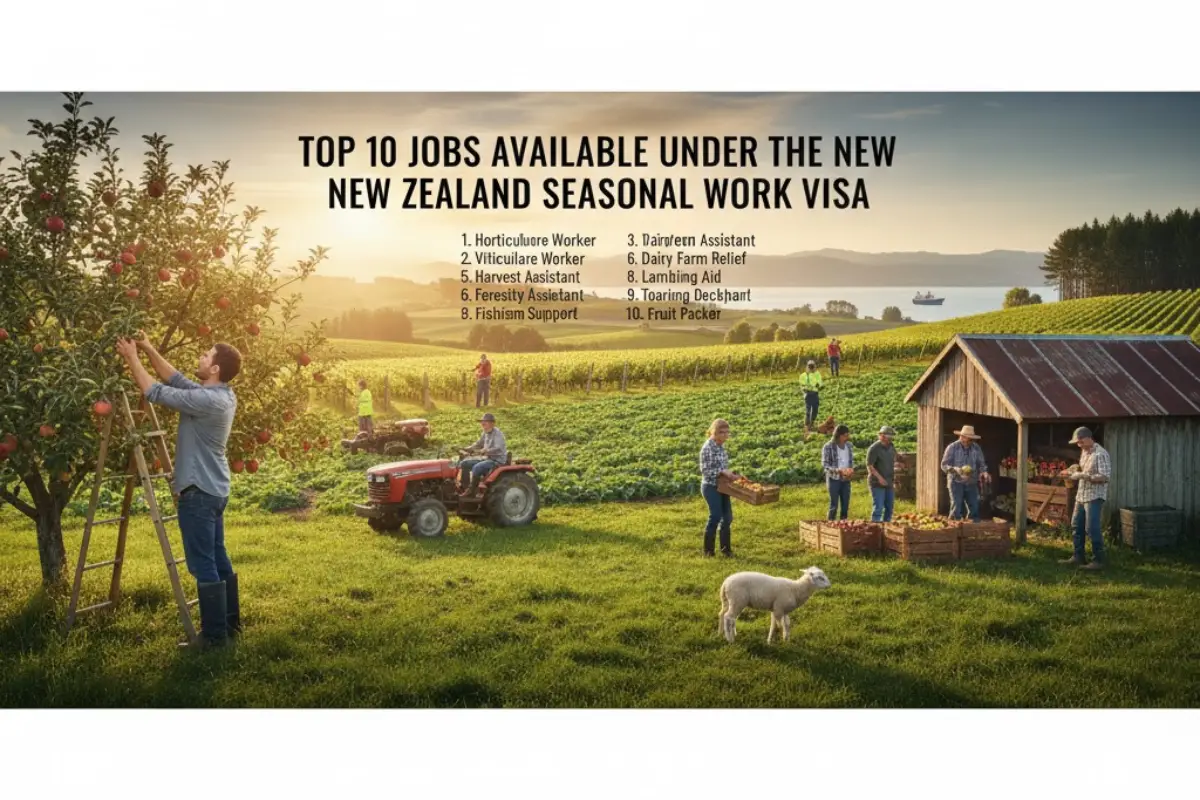
Top 10 Jobs Available Under the New Zealand Seasonal Work Visa
Table of Contents
If you want short-term work in New Zealand, the New Zealand Seasonal Work Visa is a clear and practical choice. This visa helps people come to New Zealand for busy harvest months and other seasonal peaks. In this article I’ll explain — in simple English — what the visa is, who can apply, the most common jobs, how long you can stay, how to apply, and useful tips like how to Submit NZeTA Online and where to find authoritative NZeTA Visa Information. Read through and you should have no doubts left.
What exactly is the New Zealand Seasonal Work Visa?
The New Zealand Seasonal Work Visa (often called the RSE or Recognised Seasonal Employer pathway) lets overseas workers fill short-term jobs in New Zealand’s Horticulture and viticulture industries. To apply you normally need a job offer from a Recognised Seasonal Employer. The visa is made for people who want to work for one season — usually the harvest season — then go home when the job ends.
Who can apply?
In plain words: adults (usually 18 or older) who have a confirmed job offer, are healthy enough, and pass basic character checks. The RSE scheme often works with workers from Pacific nations, but other seasonal visa options and employer categories also exist. Always check the official lists and the employer’s status before you accept an offer.
How long can you stay?
A common rule is up to 7 months in any 11-month period for most workers under the RSE-style seasonal scheme. (There are some country-specific exceptions — for example, longer stays for certain Pacific nations.) This period lines up with harvest cycles so you can work full-time through the season.
Top 10 jobs you’ll find on a New Zealand Seasonal Work Visa
Below are the most common roles. I explain what each job really means so you know what to expect.
- Fruit picker / harvester — Picking apples, kiwifruit, cherries, berries or other fruit. It is physical work, usually outdoors, and sometimes paid by how much you pick (piece-rate) or by the hour.
- Vineyard worker (grape harvesting & pruning) — Work in vineyards includes picking grapes, pruning vines, and general canopy work. Seasons vary by region and grape type.
- Packhouse worker — After fruit is picked it goes to a packhouse to be sorted and packed for markets. This work is often inside sheds and can be faster-paced.
- Orchard thinning & maintenance — Tasks like thinning fruit, tying branches, and general upkeep. Important work that can last longer than harvest weeks.
- Pruning and trellising — Skilled handwork in orchards and vineyards. If you do a careful job, employers value you a lot.
- Loader / forklift operator — If you have licences and experience, packhouses and farms sometimes need help moving pallets and crates.
- General farm hand — A mix of tasks: irrigation, fencing, planting, and general farm support. Good if you like variety.
- Packing line supervisor / team leader — Experienced seasonal workers may be asked to supervise small teams or quality checks.
- Irrigation and crop support technician — Short-term roles to set up irrigation, check pumps, or help with pest control under supervision.
- Processing and coldstore operator — Many exports need quick chilling and storing; these roles keep the supply chain moving and run during peak times.
Most of these roles show up across New Zealand regions — Hawke’s Bay, Nelson, Marlborough and many orchards near Auckland. For real job listings, industry websites like PickNZ and mainstream job boards list current seasonal vacancies.
Pay, hours and living conditions — what to expect
Pay depends on the employer and the job. Some work is paid by the hour, some by piece-rate. During harvest you can expect long days, especially when weather is good and crops ripen fast. Many employers help with accommodation or point you to shared housing — but always confirm this in writing before you travel. The official government and industry sites remind workers to check pay rates, work hours, and safety rules.
How to apply — simple steps
- Get a confirmed job offer from a Recognised Seasonal Employer. Check the official Recognised Seasonal Employer list so you know the employer is approved.
- Prepare your documents: passport, contract or job offer, medical checks if needed, and any photos or ID the visa form asks for.
- Apply for the New Zealand Seasonal Work Visa following Immigration New Zealand’s instructions. Keep copies of everything.
- If you travel on a visitor route or are from a visa-waiver country, remember to Submit NZeTA Online before you fly. Check NZeTA Visa Information on the official portal so you know processing times and traveler declaration rules. Allow at least 72 hours for NZeTA processing.
Practical tips and safety
- Get the job terms in writing: pay, hours, accommodation and length of work.
- Keep photos/scans of passport, visa and contract.
- Ask about health insurance and who to call if something goes wrong.
- Use trusted job boards like PickNZ or the official Recognised Seasonal Employer list — avoid offers that look too good to be true.
Final thoughts — is it right for you?
The New Zealand Seasonal Work Visa is a great opportunity if you want to earn money, travel, and gain work experience in a friendly country. It is short-term by design and tied to real seasonal demand. Before you go, double-check employer approval, confirm your contract, and Submit NZeTA Online if it applies to you. Read official NZeTA Visa Information and Immigration New Zealand pages so you travel prepared and safe.